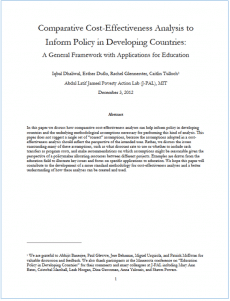
Policy highlights:
- In order to encourage policy makers to base their policy decisions on scientific evidence, scientists should include cost-effectiveness analyses in their research, because policy makers will always have to take this aspect into account when deciding on what programmes to include in their development policy framework.
- This paper presents a cost-effectiveness analysis for student attendance and enrollment to illustrate key issues that come up in such analyses. It focuses on eleven programmes from six countries, comparing their cost-effectiveness in terms of increasing children’s time in school.
- Research yielded some important insights for policy makers: 1) Informational campaigns and school-based deworming provided greatest value for money: Programmes are inexpensive and cause large increases in student attendance and enrollment; 2) Programmes that reduce costs of schooling through subsidies are effective, but more expensive; 3) Conditional cash transfer programmes are not as cost-effective to increase time in school.
- Despite the importance of these data for policy makers, for researchers it remains a challenge to appropriately measure and compare quality of learning across programmes and countries. This challenge of comparison goes for all cost-effectiveness analysis, as it remains difficult to convert all costs and impacts into “common units”.






